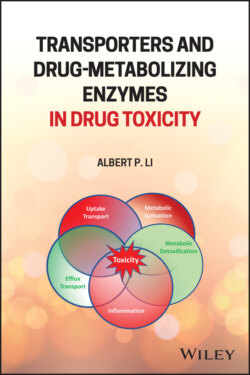Читать книгу Transporters and Drug-Metabolizing Enzymes in Drug Toxicity - Albert P. Li - Страница 19
References
Оглавление1 1 Mosedale M, Watkins PB. “Understanding idiosyncratic toxicity: lessons learned from drug‐induced liver injury”. J Med Chem 2020; 63(12): 6436–6461.
2 2 Stepan AF, Walker DP, Bauman J, Price DA, Baillie TA, Kalgutkar AS, et al. “Structural alert/reactive metabolite concept as applied in medicinal chemistry to mitigate the risk of idiosyncratic drug toxicity: a perspective based on the critical examination of trends in the top 200 drugs marketed in the United States”. Chem Res Toxicol 2011; 24(9): 1345–1410.
3 3 Li AP. “A review of the common properties of drugs with idiosyncratic hepatotoxicity and the ‘multiple determinant hypothesis’ for the manifestation of idiosyncratic drug toxicity”. Chem Biol Interact 2002; 142(1–2): 7–23.
4 4 Collins JM. “Idiosyncratic drug toxicity”. Chem Biol Interact 2002; 142(1–2): 3–6.
5 5 Park BK, Kitteringham NR, Powell H, Pirmohamed M. “Advances in molecular toxicology‐towards understanding idiosyncratic drug toxicity”. Toxicology 2000; 153(1–3): 39–60.
6 6 DiMasi JA, Grabowski HG, Hansen RW. “The cost of drug development”. N Engl J Med 2015; 372(20): 1972.
7 7 Wouters OJ, McKee M, Luyten J. “Estimated research and development investment needed to bring a new medicine to market, 2009–2018”. JAMA 2020; 323(9): 844–853.
8 8 Li AP. “A comprehensive approach for drug safety assessment”. Chem Biol Interact 2004; 150(1): 27–33.
9 9 Li AP. “An integrated, multidisciplinary approach for drug safety assessment”. Drug Discov Today 2004; 9(16): 687–693.
10 10 Mann RD. “Famous names in toxicology. Paracelsus‐‐born 500 years ago”. Adverse Drug React Toxicol Rev 1993; 12(2): 81–82.
11 11 Wilks MF. “Bringing chemistry to medicine‐the contribution of Paracelsus to modern toxicology”. Chimia (Aarau) 2020; 74(6): 507–508.
12 12 Oh RC, Malave B, Chaltry JD. “Collapse in the heat‐from overhydration to the emergency room‐three cases of exercise‐associated hyponatremia associated with exertional heat illness”. Mil Med 2018; 183(3–4): e225–e228.
13 13 O'Brien KK, Montain SJ, Corr WP, Sawka MN, Knapik JJ, Craig SC. “Hyponatremia associated with overhydration in U.S. Army trainees”. Mil Med 2001; 166(5): 405–410.
